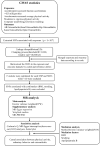Physical Activity, Sedentary Behavior, and Osteoarthritis: A Two-Sample Mendelian Randomization Analysis
- PMID: 37899916
- PMCID: PMC10612556
- DOI: 10.18502/ijph.v52i10.13848
Physical Activity, Sedentary Behavior, and Osteoarthritis: A Two-Sample Mendelian Randomization Analysis
Abstract
Background: Sedentary behavior and physical activity are still ambiguous in their effects on osteoarthritis. We aimed to evaluate the effects of physical activity and sedentary behavior on osteoarthritis to provide a reference for the prevention of osteoarthritis.
Methods: This study was conducted in Changchun, China in 2022. We used two-sample Mendelian randomization with the SNP as an instrumental variable to investigate the effect of physical activity and sedentary behavior on osteoarthritis. In addition, a two-step Mendelian randomization method was used to test whether mediating factors (BMI, smoking, Apolipoprotein B) were involved in mediating the effects of exposure factors on osteoarthritis.
Results: TV watching was causally related to knee osteoarthritis and spine osteoarthritis, and they were positively correlated (knee osteoarthritis: OR=1.162,95 %CI: 1.027-1.315, P=0.017; spine osteoarthritis: OR=1.208,95 %CI: 1.033-1.413, P=0.018). BMI played a mediating role in the process of TV watching with knee osteoarthritis and spine osteoarthritis. ((The proportion of BMI mediating effect: knee osteoarthritis: 47.1% (95% CI: 36.7%~63.2%); spine osteoarthritis: 29.5% (95% CI: 19.3%~40.8%)). The proportion of Smoking mediating effect in the process of TV watching with spine osteoarthritis was 16.1% (95% CI: 3.7% ~ 31.6%).
Conclusion: TV watching is a potential risk factor for osteoarthritis and plays a role through modifiable factors such as BMI and smoking, therefore, interventions on these factors have the potential to reduce the burden of osteoarthritis caused by longer TV watching times.
Keywords: Lifestyle; Mendelian randomization; Osteoarthritis; Sedentary behavior.
Copyright © 2023 Wang et al. Published by Tehran University of Medical Sciences.
Figures




References
-
- Tubach F, Ravaud P, Martin-Mola E, et al. (2012). Minimum clinically important improvement and patient acceptable symptom state in pain and function in rheumatoid arthritis, ankylosing spondylitis, chronic back pain, hand osteoarthritis, and hip and knee osteoarthritis: Results from a prospective multinational study. Arthritis Care Res (Hoboken), 64(11):1699–707. - PubMed
-
- Braun J, Sieper J. (2007). Ankylosing spondylitis. Lancet, 369(9570):1379–90. - PubMed
LinkOut - more resources
Full Text Sources
